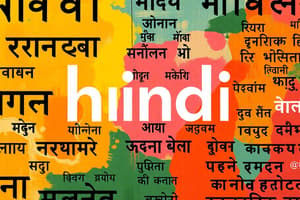Podcast
Questions and Answers
What is the primary script used to write Hindi?
What is the primary script used to write Hindi?
- Cyrillic
- Devanagari (correct)
- Arabic (correct)
- Latin
Which sentence structure is primarily used in Hindi?
Which sentence structure is primarily used in Hindi?
- Object-Subject-Verb (OSV)
- Verb-Subject-Object (VSO)
- Subject-Object-Verb (SOV) (correct)
- Subject-Verb-Object (SVO)
Which of the following is NOT a dialect of Hindi?
Which of the following is NOT a dialect of Hindi?
- Bhojpuri
- Punjabi (correct)
- Haryanvi
- Braj Bhasha
From which language does Hindi derive a significant portion of its vocabulary?
From which language does Hindi derive a significant portion of its vocabulary?
What is one major cultural medium through which Hindi has gained global influence?
What is one major cultural medium through which Hindi has gained global influence?
How many people approximately speak Hindi worldwide?
How many people approximately speak Hindi worldwide?
Which aspect of Hindi grammar includes a complex system of verb conjugation?
Which aspect of Hindi grammar includes a complex system of verb conjugation?
What is a common resource for learning Hindi?
What is a common resource for learning Hindi?
Flashcards are hidden until you start studying
Study Notes
Overview of Hindi
- Hindi is an Indo-Aryan language spoken primarily in India.
- It is one of the official languages of India and is used in government, media, and education.
- Hindi is part of the wider group of Indian languages that includes Urdu, Punjabi, and Bengali.
Linguistic Features
- Script: Written in Devanagari script, which is an abugida; each character represents a consonant with an inherent vowel sound.
- Phonetics: Contains a rich set of sounds, including retroflex consonants.
- Grammar:
- Sentence Structure: Typically follows the Subject-Object-Verb (SOV) order.
- Tenses: Uses a complex system of verb conjugation and aspect marking.
- Gender: Nouns are classified as masculine or feminine.
Dialects
- Hindi has numerous dialects that can vary significantly in pronunciation and vocabulary, including:
- Bhojpuri
- Awadhi
- Braj Bhasha
- Haryanvi
Vocabulary
- Hindi vocabulary is derived from:
- Sanskrit (significant influence)
- Persian (due to historical Mughal influence)
- Arabic (also due to invasions)
- English (modern terminology and globalization)
Cultural Significance
- Hindi is a carrier of rich cultural history, literature, and poetry.
- Bollywood, the Hindi film industry, has a massive global influence, spreading the language and culture internationally.
Global Presence
- Hindi is spoken by around 600 million people worldwide, making it one of the most spoken languages.
- Significant diaspora communities in countries such as the United States, Canada, the UK, and Australia.
Learning Hindi
- Resources for learning include:
- Language courses (online and in-person)
- Textbooks and language apps
- Immersive environments, such as travel and interaction with native speakers.
Key Takeaways
- Hindi is a major language with deep cultural roots and significant global impact.
- Understanding its structure, vocabulary, and dialects is essential for language learners.
- Hindi continues to evolve, influenced by other languages and cultures.
Overview of Hindi
- Hindi is an Indo-Aryan language spoken primarily in India.
- It is one of the official languages of India and is used in government, media, and education.
- Hindi is part of the wider Indian language group, which includes Urdu, Punjabi, and Bengali.
Linguistic Features
- Hindi is written in the Devanagari script, which is an abugida - each consonant has an inherent vowel sound.
- Hindi has a unique set of retroflex consonants in its phonetics.
- Hindi grammar follows a Subject-Object-Verb (SOV) sentence structure.
- Hindi uses a complex system of verb conjugation and aspect marking for tenses.
- Hindi nouns are categorised as masculine or feminine in gender.
Dialects
- Hindi has many dialects, including Bhojpuri, Awadhi, Braj Bhasha, and Haryanvi. These dialects vary in pronunciation and vocabulary.
Vocabulary
- Hindi vocabulary is heavily influenced by Sanskrit.
- Persian and Arabic have also contributed to Hindi vocabulary due to historical factors.
- Modern terminology and globalisation have brought English influences to Hindi.
Cultural Significance
- Hindi plays a significant role in Indian culture, carrying a rich history of literature and poetry.
- Bollywood, the Hindi film industry, has immense global influence, spreading both the language and Indian culture worldwide.
Global Presence
- Hindi is spoken by over 600 million people globally, making it one of the most spoken languages.
- There are large Hindi diaspora communities in countries like the United States, Canada, the UK, and Australia.
Learning Hindi
- Resources for learning Hindi include language courses, textbooks, language apps, as well as immersion experiences (travel and interaction with native speakers).
Key Takeaways
- Hindi is a major language with deep cultural roots and significant global impact.
- Understanding its structure, vocabulary, and dialects is essential for learners.
- Hindi continues to evolve, influenced by other languages and cultures.
Studying That Suits You
Use AI to generate personalized quizzes and flashcards to suit your learning preferences.



